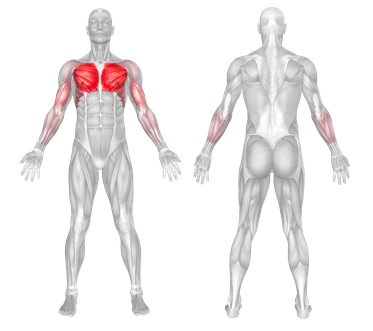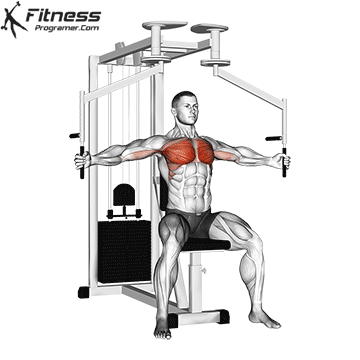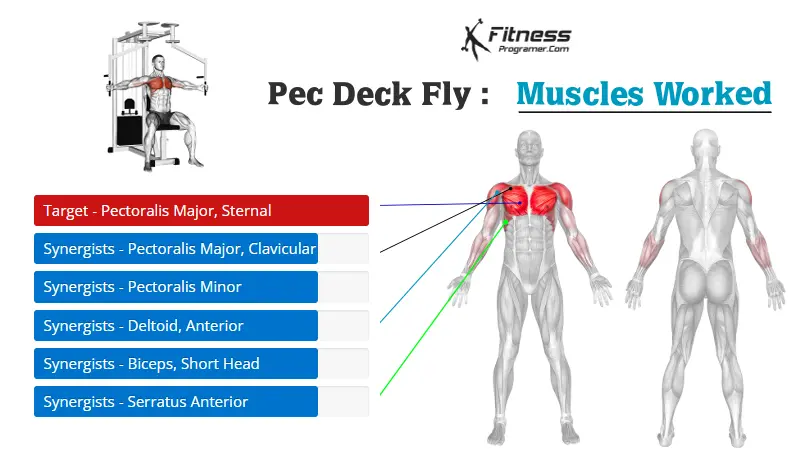Pec Deck Fly / Machine Fly: Overview
The pec deck fly is a machine-based isolation exercise that primarily targets the chest muscles. It is performed on a special machine that provides a controlled and stable movement that reduces the risk of injury compared to other chest exercises that require free weights. The machine acts as a stabilizer here, emphasizing the pectoralis major and pectoralis minor muscles in the chest. This isolation exercise, which combines pushing and compression movements, helps develop and strengthen the chest muscles.
How to Perform Pec Deck Fly
Here are the steps to perform the Pec deck fly:
Adjust the Machine: Set the seat so handles are at chest level. Adjust arm pads so your arms are slightly behind your torso to begin.
Sit Tall: Place your feet flat, back pressed against the pad, and grasp the handles or rest forearms against pads (depending on machine type).
Set Arm Position: Keep a slight bend in the elbows to protect your joints.
Initiate the Movement: Exhale and bring the arms together in front of your chest in a hugging motion. Focus on squeezing your chest muscles at the peak.
Return With Control: Slowly reverse the movement until you feel a mild stretch in the chest. Avoid letting weights slam or overstretching.
Tips for Proper Form
Maintain constant tension on the pecs—avoid letting weights rest at the bottom.
Keep your shoulders depressed and back flat against the pad.
Don’t hyperextend or lock out your elbows at the peak.
Squeeze your chest hard at the midpoint for maximum activation.
Use a full range of motion, but don’t overstretch your shoulders.
Common Mistakes
Letting the elbows straighten too much (overloads joints, not muscles).
Using excessive weight, leading to swinging or jerky motion.
Shrugging shoulders up during the contraction phase.
Not controlling the eccentric (return) phase of the movement.
Skipping warm-up sets and jumping into heavy loads.
Benefits of Pec Deck Fly
Here are some potential benefits of incorporating the Pec Deck Fly into your chest workout routine:
- Isolates the Chest Muscles: Targets the pectoralis major with minimal involvement from deltoids or triceps, ideal for hypertrophy.
- Encourages Muscle Symmetry: Bilateral movement ensures equal load distribution, helping correct imbalances between sides.
- Joint-Friendly: The machine’s guided path removes the need for stabilization, making it safer for people with shoulder issues.
- Enhances Mind-Muscle Connection: The fixed arc and isolation allow users to concentrate fully on squeezing the pecs.
- Great for Pre-Exhaustion or Finishing: Perfect for pre-fatiguing the chest before pressing movements or finishing a chest workout with intensity.
How to Incorporate Into Your Routine
For Hypertrophy: 3–4 sets of 10–15 reps with 60–90 sec rest, focus on tempo and squeeze.
As a Finisher: Add 2–3 high-rep sets at the end of your chest day to burn out the pecs.
For Beginners: Use lighter weight, controlled tempo (3s eccentric), and learn to feel chest activation.
For Pre-Exhaustion: Do before bench press to fatigue the pecs and shift emphasis from triceps.
In Supersets: Pair with push-ups, dips, or incline presses for volume and contrast.
For Joint-Friendly Training: Use instead of dumbbell flys if you have shoulder instability or pain.
Pec Deck Fly – Muscles Worked
The Pec Deck Fly primarily targets the pectoralis major, specifically the sternal head. However, it also works other muscles in the chest, as well as the shoulders and arms. Here is a breakdown of the muscles worked during the Pec Deck Fly:

Frequently Asked Questions
Is the Pec Deck Fly better than Dumbbell Flys?
It depends. The pec deck offers stability and safer joint positioning, making it better for isolation and hypertrophy. Dumbbells require more stabilization and offer more stretch but also more risk.
Can this exercise build a bigger chest?
Yes, when combined with pressing movements and progressive overload, it helps add mass and shape, particularly in the inner and lower chest.
How heavy should I go?
Use a moderate weight that allows full range of motion and control. Focus more on contraction and stretch than on maxing out the machine.
Is this suitable for shoulder rehab?
Yes, especially when supervised and performed with a short range of motion and light weight. It avoids external rotation stress.
What’s the ideal rep range?
8–15 reps for hypertrophy; higher reps (15–20) for finishers or metabolic stress. Tempo can enhance time under tension.


